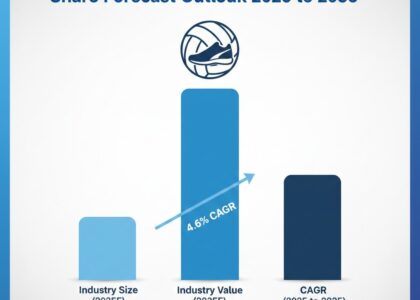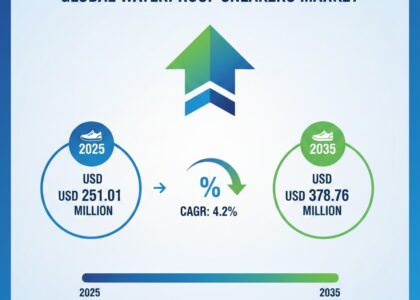
The global dicamba market is projected to grow at a robust CAGR of 7.90% during the forecast period. Valued at USD 532.41 million in 2023, the market is expected to reach approximately USD 1,340 million by 2035, fueled by the rising adoption of dicamba-tolerant crops and increasing pressure to boost agricultural productivity.
Stay Informed on Key Market Changes: Get a Sample Report! https://www.futuremarketinsights.com/reports/sample/rep-gb-2556
Driving Forces Behind Market Growth:
- Herbicide Resistance Crisis:
Farmers globally are witnessing reduced efficacy of traditional herbicides like glyphosate. Dicamba, with a different mode of action, offers an effective alternative to manage glyphosate-resistant weed species such as palmer amaranth and waterhemp. - Adoption of Dicamba-Tolerant GM Crops:
Biotech firms have developed genetically modified crops (notably soybean and cotton) that are tolerant to dicamba. The increased cultivation of these varieties is significantly boosting product usage. - Demand for Higher Agricultural Yields:
As the global population grows and arable land shrinks, maximizing yields through efficient weed control has become a necessity. Dicamba’s broad-spectrum action ensures cleaner fields and better yields. - Expansion of Conservation Agriculture:
No-till and minimum-till farming practices are increasing, especially in North America and Europe. These practices demand effective chemical weed control, making dicamba a key input in such systems. - Government Support for Crop Protection Products:
Several governments are providing subsidies and regulatory approvals to herbicides that offer selective weed control while ensuring environmental compliance—factors that favor dicamba adoption.
Market Challenges & Strategic Responses:
- Drift and Volatility Concerns:
One of the most significant issues associated with dicamba is its tendency to drift onto non-target crops, causing unintended damage. This has led to legal disputes and regulatory reviews, especially in the U.S.
Strategic Response:
Manufacturers are investing in low-volatility formulations and application technology improvements (e.g., buffer zones, drift-reduction nozzles) to mitigate off-target movement.
- Regulatory Scrutiny:
Due to environmental and health concerns, several regulatory agencies have imposed strict conditions on dicamba application—limiting its usage window and requiring special licensing.
Strategic Response:
Industry leaders are working closely with regulators to demonstrate product safety, while also expanding to countries with more favorable policies.
- Rise of Alternative Herbicides:
With growing research in biological weed control and other synthetic herbicides, dicamba faces competitive pressure from both traditional and novel solutions.
Strategic Response:
Leading players are bundling dicamba with other herbicide chemistries in integrated weed management packages to extend effectiveness and reduce resistance buildup.
Regional Market Outlook:
- North America:
Dominates the global dicamba market due to widespread adoption of herbicide-tolerant GM crops, especially in the United States. Regulatory debates continue but haven’t dampened farmer demand. - Latin America:
A rapidly growing market, particularly in Brazil and Argentina, where soybean cultivation is expanding, and weed resistance is rising. - Asia-Pacific:
Steady growth driven by China and India, where food security and agricultural modernization are top national priorities. Adoption of herbicide-tolerant seeds remains lower but is gradually increasing. - Europe:
Slower growth due to tighter pesticide regulations and growing public resistance to chemical herbicides. However, Eastern Europe shows more potential due to conventional farming practices. - Middle East & Africa:
Emerging markets with limited but growing adoption. Governments are increasingly investing in crop protection to address food self-sufficiency.
Company Profile and Competitive Landscape:
The global dicamba market is moderately consolidated, with a few key players dominating the majority of market share. The competitive environment is shaped by product efficacy, regulatory compliance, distribution networks, and brand reputation.
Key Companies Include:
- BASF SE:
One of the market leaders, BASF provides dicamba-based herbicides like Engenia®, with a strong focus on low-volatility formulations and stewardship programs. - Bayer AG (Monsanto):
Offers XtendiMax®, a prominent dicamba herbicide designed to pair with its XtendFlex® soybean and cotton seeds. Bayer has been actively involved in managing litigation and regulatory pressures in the U.S. - Corteva Agriscience:
Offers dicamba in combination with other herbicides as part of integrated weed management strategies. - Nufarm Limited:
Supplies dicamba herbicides in Latin America and Australia, focusing on formulation innovation and regional expansion. - Syngenta AG:
Combines dicamba with other modes of action to provide resistance management in key crops.
Other regional players and generic manufacturers contribute to market diversity, especially in price-sensitive regions like India and Southeast Asia.
Share Forecast Outlook:
- Soybean and cotton sectors will remain the dominant end-use segments, accounting for over 60% of total dicamba consumption by 2035.
- Formulation innovations and technology-driven application systems will continue to influence market share distribution.
- North America and Latin America combined are expected to retain over 50% of the global market by value throughout the forecast period.
The Road Ahead:
- Regulatory Adaptation:
The future of dicamba depends heavily on how companies address drift-related issues and comply with evolving regulations. - Technology Integration:
Precision farming, drone spraying, and data-driven application models are expected to make dicamba usage safer and more efficient. - Product Development:
Continued R&D in tank-mix compatibility, low-volatility blends, and multi-mode herbicide packages will shape competitive advantage. - Sustainability:
As global agriculture leans into sustainable practices, dicamba’s place will depend on how well it aligns with environmental standards and integrated weed management principles. - Global Expansion:
Untapped markets in Africa, Southeast Asia, and Central Asia present growth opportunities as agricultural modernization spreads.
Key Players in the Global Dicamba Market
- BASF SE
- Monsanto Co.
- E I du Pont de Nemours & Company
- Bayer AG
- The Dow Chemical Company
- Syngenta AG
- Nufarm Limited
Key Segments in the Global Dicamba Market
By Physical Form:
- Liquid
- Dry
By Application:
- Agriculture
By Time Application:
- Post-emergence
- Pre-emergence
By Crop Type:
- Cereal & grains
- Oilseeds & pulses
- Pastures & forage crops
By Region:
- North America
- Latin America
- Western Europe
- Eastern Europe
- Asia Pacific Excluding Japan (APEJ)
- Middle East & Africa
- Japan
Buy Now: https://www.futuremarketinsights.com/checkout/2556
About Future Market Insights (FMI)
Future Market Insights, Inc. (ESOMAR certified, recipient of the Stevie Award, and a member of the Greater New York Chamber of Commerce) offers profound insights into the driving factors that are boosting demand in the market. FMI stands as the leading global provider of market intelligence, advisory services, consulting, and events for the Packaging, Food and Beverage, Consumer Technology, Healthcare, Industrial, and Chemicals markets. With a vast team of over 400 analysts worldwide, FMI provides global, regional, and local expertise on diverse domains and industry trends across more than 110 countries. Join us as we commemorate 10 years of delivering trusted market insights. Reflecting on a decade of achievements, we continue to lead with integrity, innovation, and expertise.
Contact Us:
Future Market Insights Inc.
Christiana Corporate, 200 Continental Drive,
Suite 401, Newark, Delaware – 19713, USA
T: +1-347-918-3531
For Sales Enquiries: sales@futuremarketinsights.com
Website: https://www.futuremarketinsights.com
LinkedIn| Twitter| Blogs | YouTube





